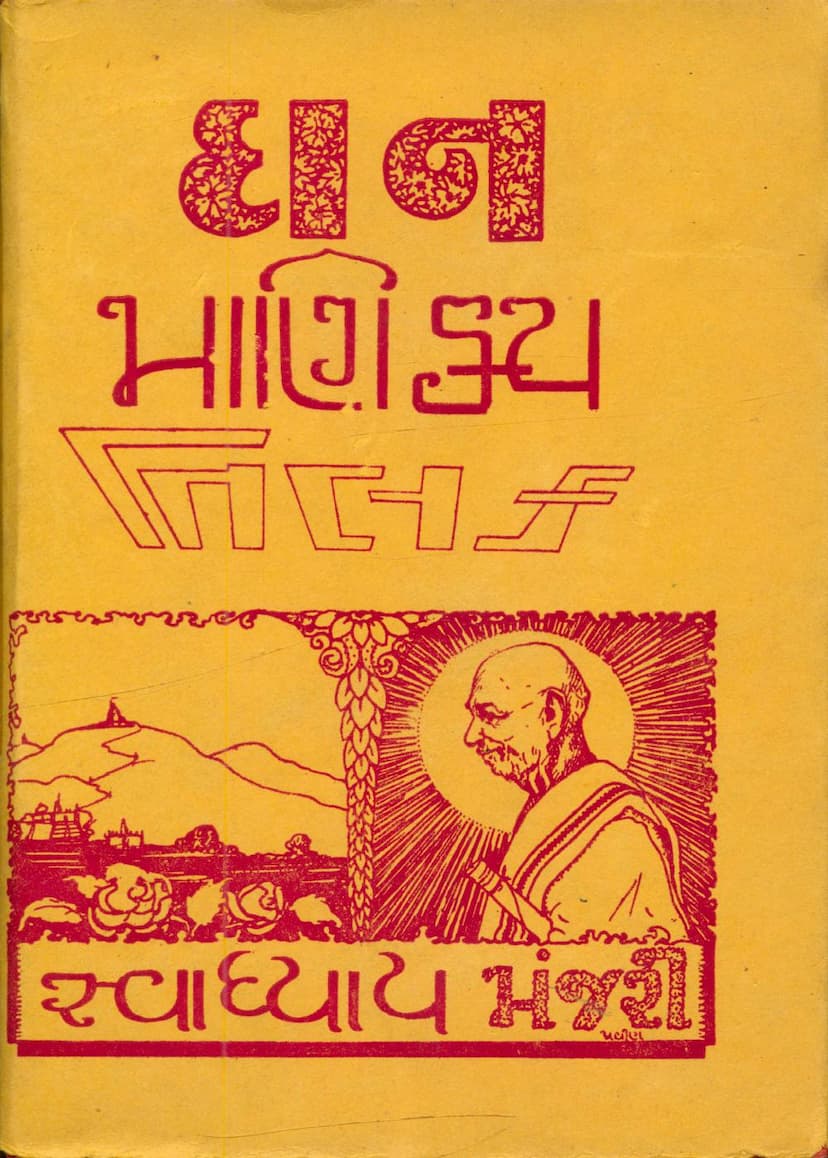Swadhyay Manjari
Added to library: September 2, 2025

Summary
This document appears to be a Jain religious text, titled "Swadhyay Manjari" (स्वाध्याय मञ्जरी), published by Shantinath Jain Derasar. The catalog link provided leads to a collection of Jain texts. The document itself seems to be a compilation of various Jain scriptures, prayers, and biographies, primarily in Gujarati.
Based on the provided pages, here's a comprehensive summary in English:
Overall Purpose and Content:
"Swadhyay Manjari" appears to be a collection intended for spiritual study and reflection ("Swadhyay" means self-study, and "Manjari" often refers to a cluster or collection of flowers, implying a collection of valuable spiritual insights). The book is dedicated to and memorializes the virtues of revered Jain ascetics, particularly Pujya Pravartini Saviji Maharaj Shri Manekshriji M. (पूज्य प्रवर्तनी साध्वीजी महाराज श्री माणेकश्रीजी म.). The text includes:
-
Invocations and Devotional Content:
- Pages 2 and back pages (69-75) contain various Jain prayers and stotras like "Shri Atmaraksha Navkar Mantra" (श्री आत्मरक्षा नवकार मन्त्र), "Shri Vajrapanjar Stotra" (श्री वज्रपञ्जर स्तोत्र), "Shri Navkar Sutra" (श्री नवकार सूत्र), "Shri Uvasaggahar" (श्री उवस्सग्गहर), "Shri Santikar Stavan" (श्री शान्तिफर स्तोत्र), and "Shri Vijayapahut Stotra" (श्री विजयपहुत स्तोत्र). These are devotional hymns aimed at seeking protection, peace, and spiritual progress.
- The collection includes the "Maha Prabhavik Nav Smaran" (महासमाविक न स म रण - Nine Powerful Recollections/Prayers), highlighting their spiritual significance.
-
Biography of Revered Ascetics:
- A significant portion of the document (pages 6-54, and later pages like 21-48, 57-61) is dedicated to the life and teachings of Pujya Pravartini Saviji Maharaj Shri Manekshriji M. (पूज्य प्रवर्तनी साध्वीजी महाराज श्री माणेकश्रीजी म.).
- Her biography details her birth in Vadodara, her spiritual upbringing, her strong renunciation of worldly life despite her family's influence, her initiation, her extensive travels (vihars) across India, her rigorous penances (tapasya), her scholarly pursuits, her sermons (vyakhyans), and her dedication to spiritual practices and the propagation of Jain dharma.
- The biography emphasizes her unwavering faith, courage, compassion, and profound spiritual strength, even during challenging times like the partition of India.
- It also mentions her disciples, like Sadhvishri Tilakshriji M., Prabhshriji M., and Bhadrashriji M., and the lineage of her spiritual gurus.
- The biography of Pujya Sadhvishri Sudarshanashriji M. (पू. साध्वीश्री सुदर्शनाश्रीजी म.) is also included, mentioning her birth in Kapadvanj, her family, and her daughters who also took up the spiritual path.
-
Compilation of Jain Scriptures and Principles:
- The text appears to draw heavily from scriptures like the Uttaradhyayan Sutra (श्री उत्तराध्ययन सूत्र), evident from the chapter titles and content (e.g., Chapter 1: Ath Vinayadhyayan, Chapter 2: Ath Parishahajayan, Chapter 3: Ath Chaturangiyam, Chapter 4: Ath Pramadsthan, Chapter 5: Ath Akam Maraniyakhya, Chapter 6: Ath Kshudranirgranthiyakhya, Chapter 7: Ath Mrigaputriyakhya, Chapter 8: Ath Kashaliyakhyam, Chapter 9: Ath Namipravrajya, Chapter 10: Ath Kumpatrakhyam, Chapter 11: Ath Bahushrutapujya, Chapter 12: Ath Harikeshiyakhya, Chapter 13: Ath Chitrashambhuyakhya, Chapter 14: Ath Pramadsthana, Chapter 20: Ath Kashaliyakhyam, Chapter 21: Ath Samudrapalinyakhya, Chapter 22: Ath Rathnemi, Chapter 23: Ath Keshigautamiyakhya, Chapter 25: Ath Samayacharyasannja, Chapter 26: Ath Brahmacharyasamadhisthaniyat, Chapter 28: Ath Mokshamarga, Chapter 29: Ath Samyaktvaprakrama, Chapter 30: Ath Tamagatyakhya, Chapter 31: Ath Charitravidhi, Chapter 32: Ath Pramadsthana, Chapter 33: Ath Karmaprakritisanagraha, Chapter 34: Ath Leshyana, Chapter 35: Ath Anagar Marg, Chapter 36: Ath Jivajivavibhakt, and Chapter 37: Ath Samyaksatva).
- The detailed breakdown of karmic principles in chapters like "Panch Sangrah" (Panch Sangrah - Five Collections) and "Karmaprakriti Sangrah" (कर्मप्रकृति संग्रह) indicates a focus on the intricate Jain philosophy of karma, its types, durations, effects, and methods of overcoming it. This section is highly technical and enumerates various karmic subdivisions and their workings.
- The inclusion of stotras like "Bhaktaamar Stotra" (श्री भक्तामर स्तोत्र) and "Kalyana Mandir Stotra" (श्री कल्याण मंदिर स्तोत्र) further suggests the devotional aspect of the compilation.
-
Eulogies and Gratitude:
- The text begins with expressions of reverence and tribute, particularly to Pujya Guruvar Shri Manekshriji M. (पूज्य गुरुवर श्री माणेकश्रीजी म.) on pages 6-7, acknowledging her immense contribution to their spiritual journey.
- There are acknowledgments and thanks to various individuals and organizations (pages 14-17) for their financial support, highlighting the collaborative effort in publishing this work. This includes names of donors, often mentioning their locations and family connections, which is common in Indian religious publications.
-
Genealogical Charts:
- The document includes a "Vansh Vriksh" (वंश वृक्ष - family tree) of the preceptor line of Pujya Pravartini Shri Manekshriji M. (पू. प्रवर्तनी श्री माणेकश्रीजी म.), illustrating the lineage of revered Jain monks and nuns.
Key Themes:
- Renunciation and Asceticism: The life of Manekshriji is portrayed as an epitome of renunciation, penance, and spiritual discipline.
- Spiritual Knowledge and Study (Swadhyay): The title itself and the inclusion of various scriptures emphasize the importance of self-study and understanding of Jain philosophy.
- Devotion and Reverence: The prayers, stotras, and the overall tone of reverence for the spiritual guides highlight the devotional aspect of Jainism.
- Karma and Liberation: The detailed exposition of karmic principles points to the central Jain concept of karma and the path to liberation (moksha) through virtuous conduct and penance.
- Ethical Conduct and Virtues: The life stories and principles embedded in the text emphasize virtues like non-violence (ahimsa), truthfulness, restraint (sanyam), forgiveness, compassion, and detachment.
- The Role of Gurus: The text consistently portrays the guru (spiritual teacher) as a vital guide and source of inspiration for spiritual progress.
Language:
The primary language of the text is Gujarati, as indicated by the script and content. The summary is provided in English as requested.
In essence, "Swadhyay Manjari" is a rich compilation for Jain followers, offering spiritual guidance, devotional practices, and a deep dive into the philosophical underpinnings of Jainism, with a strong emphasis on the exemplary life of Sadhviji Maharaj Shri Manekshriji.